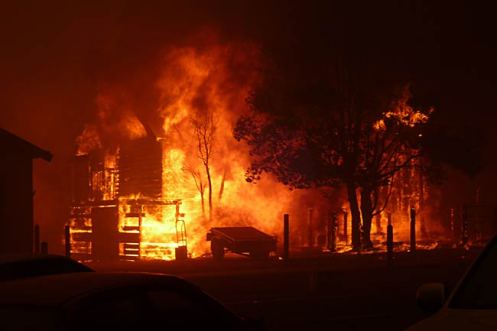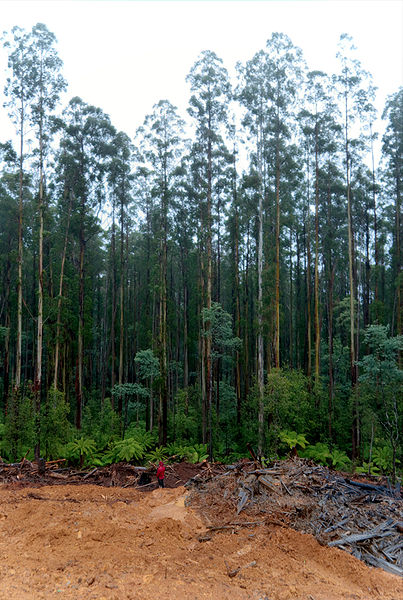Victoria’s Black Saturday bushfires could lead to a decrease in water yield in catchments.

Photo :taken by Jake Valance of Bushfire at Kinglake (HeraldSun Readers witness gallery)
As a native Victorian I have been overwhelmed by sadness following the horrific bushfires of Black Saturday. My thoughts remain with the victims who have lost so much and I send them my condolences.
Having only just returned from an extended trip to Melbourne I had experienced the blazing heat and witnessed the dryness of the prolonged drought that Victoria has been suffering. As a child I remember that summer always brought out the fear of impending bushfires, a mindset that I had all but forgotten while living in Sydney for the last few years.
Memories of the smoke and threatening angry red glow in the sky, and the accompanying fear we experienced for so many summers, came back to me vividly during the past days.
It has been interesting to look back on the history of Victoria’s bushfires and especially the 1939 Black Friday conflagration and its lead up and aftermath. There is a striking similarity in lead up meteorological conditions and a surprising realisation that there are more difficulties to come from a little mentioned consequence of the fires: decreased water yields from the destruction of the mountain ash forests in the catchment areas
This is not due to turbidity as a result of the runoff and contamination from the fires, but rather due to the effects of the destruction of the Mountain Ash forests themselves. This impact has been known about and investigated and attempted to be mitigated against by Water Authorities for many years
In fact the Australian Journal of Water Resources quoted from a recent study on the impacts of the Canberra bushfires:
Bushfires in Melbourne’s water supply catchments in 1939 produced large decreases in yield that persisted for 50 years as mountain ash forests regrew. The Cotter fires raised concerns over yield decline and short and long term water quality impacts.
A submission to the Victorian Bushfires Inquiry of 2003 had this to say:
Melbourne Water has undertaken considerable research since the 1950’s….this world recognised research was prompted by the fact that 50% of Melbourne’s upland catchments are Mountain Ash forests(which can be killed by severe bushfire) Because these forests grow on deep profile soils they are estimated to produce 80% of Melbourne’s water.
Studies have shown that water uptake by Mountain Ash regrowth, following bushfire or logging, can reduce water yield in disturbed areas by up to 50% of pre-disturbance runoff, some 20-30 years after a bushfire. The impact on water yield is most pronounced in drought years when streamflow can be significantly compromised due to greater uptake of water by regrowth trees.
Therefore this shows that following the regrowth after a bushfire there can be “significantly less “left-over rainfall” to appear as streamflow, so water yield from regrowth forest catchments is less than from mature forests.
eWater CRC further posits that
“the impact has not been felt in South Eastern Australia in the fires of 2001/2002, 2003/2003 and 2006/2007 because these have occurred in less sensitive dry sclerophyll forests, where most of the tree species can survive- damaged, but not dead. Younger trees and understorey may be killed, but these will quickly be replaced by a mixture of species adapted to the ashbed conditions.Therefore, the major reductions in water yield seen after wildfire in the Mountain Ash forests should be regarded as a worst case scenario.”
and
‘The outstanding historical example is from the wildfire in the Melbourne water-supply catchments on “Black Friday” in 1939. In that fire, mature Mountain Ash (Eucalyptus regnans) forests were killed. Over the next 30 years, water yield from local areas of regrowth diminished by up to 600 mm/year, or 6 megalitres/hectare. On a catchment-wide basis, where regrowth occupied some 50% of the area, this represented a reduction in annual streamflow of about 24%. By age 75-100, it is expected that water yield will have recovered to the pre-fire condition.’
In fact Melbourne Water in The Source wrote 8 years ago to the day about the sensitivity of the Mountain Ash forests.
Pat O’Shaughnessy, one of the pioneers of the research on the mountain ash catchments, is quoted by them as saying that on average, the ash forests reach their maximum water yield after 120 years following a minimum of about 30 years (when the trees are soaking up a lot more water).
Mr O’Shaughnessy, a Research Forester with Melbourne Water from 1967 to 1993, has underscored the potential benefit and importance of the mature Mountain Ash forests:
“If no wildfires occur, then the yield from the existing catchments is expected to increase at a rate of 2000 to 3000 megalitres per year over the next 50 years….If extensive bushfires were to hit the catchments, the rapidly regenerating mountain ash seedlings would soak up copious amounts of water, leaving significantly less water to go through the soil into streams and, eventually, reservoirs.”
Obviously then, the worst case scenario has now occurred and the impact will be felt in water yield for decades to come. It is an irony that the Mountain Ash forests require bushfires for their continued existence. Their role in the water cycle of the catchment areas will now place greater costs on governments and other authorities to manage regrowth. There will need to be more discussion about the unique problems posed by regrowth for water availability if drought continues or if climate change brings about further and more regular extreme conditions.
However, the impact of these fires will regrettably flow on for years to come and be felt by all Victorians and the prospect of such a challenge on an already drought affected State is a real disaster.
FURTHER READING:
A wonderful award winning interactive website on 1939 Black Friday includes an informative history of bushfires and a wealth of information: http://www.abc.net.au/blackfriday/misc/about.htm
Another site with further interesting links http://www.science.org.au/nova/103/103sit.htm
PHOTO:Uniform trees in Victoria’s Central Highlands, showing regrowth 69 years after the 1939 Black Friday fires. The foreground is an area devastated by recent logging.
Photo courtesy Peter Halazc, 21 June,2006.
http://commons.wikimedia.org/wiki/File:1939_Regrowth_01_Pengo.jpg

Victorian Mountain Ash
Finally please help the bushfire victims.
You can donate to the Red Cross Appeal here or make a direct deposit to the Victorian Bushfire Relief Fund –
BSB 082-001, Account number 860-046-797.
~ by abstraktbiblos on Thursday, 12 February, 2009.
Posted in Green Issues, News, Social Policy
Tags: Black Saturday 2009, bushfires, Melbourne water-supply catchments, Mountain Ash forests, water yield


